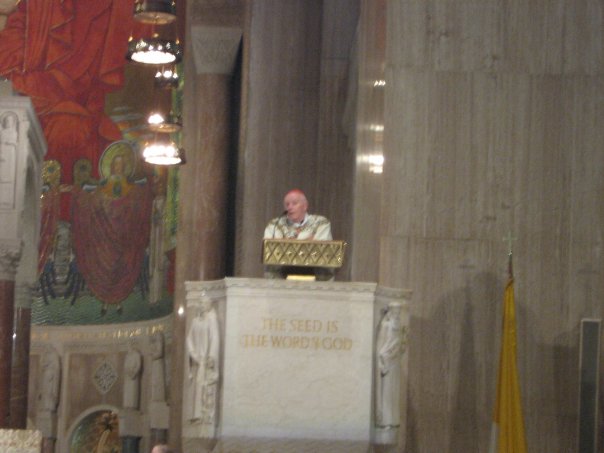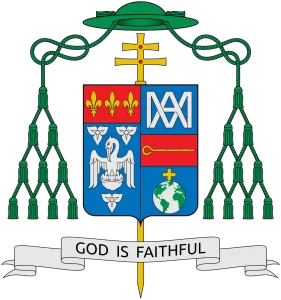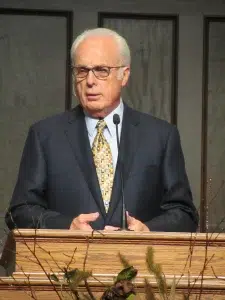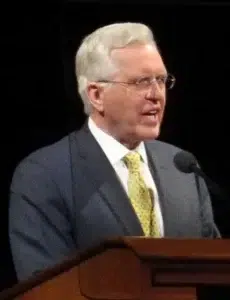Photo: Cardinal McCarrick’s final homily as Cardinal Archbishop of Washington at the National Shrine; via Wikipedia.
Peter Feuerherd, former National Catholic Reporter (NCR) news editor, writing for the NCR at 60 Years feature series, reflects on how the NCR tried to expose the Theodore McCarrick scandal but hit a wall of silence, and how over decades of the ensuing scandal, Father Boniface Ramsey kept raising the alarm with church leaders about McCarrick’s sexual misconduct.
“It was a story that got away from the National Catholic Reporter,” Feuerherd begins.
NCR attempted, and ultimately failed, to confirm long-rumored abuse allegations against Theodore McCarrick, the former cardinal and archbishop of Washington, D.C., before they became national headlines.
One of the reporters who investigated the case was Joe Feuerherd, the late brother of the author, and former editor and publisher of NCR.
McCarrick died in April at age 94. His death prompted renewed discussion of the decades of abuse and cover-up tied to his name. This summer also marks the seventh anniversary of when the allegations against him became public.
Among the few voices who consistently sounded the alarm was Father Boniface Ramsey, a former seminary professor now serving as a parish priest in Queens, New York. According to Ramsey, he began warning Church officials about McCarrick’s behavior as early as the 1980s. Those warnings, he said, were largely ignored.
One such warning was documented in a letter dated October 11, 2006, from Archbishop Leonardo Sandri at the Vatican. It referenced a November 2000 letter Ramsey had sent to the Vatican’s U.S. nuncio about McCarrick’s alleged sexual abuse.
Following McCarrick’s death, Ramsey issued a statement acknowledging the pain triggered by news coverage of the former cardinal.
“For those whom he victimized and hurt, those memories will probably — understandably — be filled with rage, especially because, although he was punished by the Church as much as the Church was capable of punishing someone, he was never punished by civil law, and he never acknowledged the hurt that he caused,” Ramsey wrote.
The first credible public allegation of McCarrick abusing a minor came in 2018, following an investigation by the Archdiocese of New York. That case opened the floodgates. Additional victims came forward, including former seminarians. The New York Times published a story revealing McCarrick’s history of sexually harassing men training for the priesthood.
Fr. Hans Zollner, then a papal adviser on abuse prevention, credited the #MeToo movement for creating momentum around addressing sexual harassment in the Church. The initial report encouraged others, including former Newark seminarian and attorney Robert Ciolek, to speak publicly.
According to Sharon Otterman, co-author of the New York Times exposé, “Ciolek wasn’t that hard to track down — his name had been floating around as someone to speak with among advocates for people sexually abused by clergy. What was different was that he was finally willing to speak, breaking open this story.”
Although the reports of child abuse shocked many, stories of McCarrick’s misconduct with seminarians were already circulating. The author learned of these beach house harassment accounts through his brother Joe, who had corresponded with Ramsey.
At the time, Joe had received a letter from Ramsey criticizing an earlier NCR article for painting McCarrick in a positive light. Ramsey had shared details about McCarrick’s weekend retreats with seminarians, where the number of attendees regularly exceeded available beds. Joe investigated but was unable to confirm the allegations. Like many journalists pursuing the McCarrick story, he ran into a wall of silence.
Ramsey said that over the years, he was punished for speaking out. After voting to expel a seminarian favored by McCarrick, Ramsey was removed from a formation council. He later left the Dominicans and became a priest in the Archdiocese of New York.
He continued raising concerns about McCarrick well into the 2000s. Ramsey said he would alert bishops when McCarrick appeared in public, such as during the 2015 funeral of Cardinal Edward Egan, despite being told by Pope Benedict XVI to maintain a low profile.
In his prime, McCarrick was a prominent figure—an eloquent speaker, skilled diplomat, and familiar face on national television. He consulted with U.S. presidents, appeared on “Meet the Press,” and led services attended by the political elite, including the funeral of Senator Ted Kennedy.
Even amid rumors, McCarrick remained active in high-profile Church functions. In 2010, he represented U.S. bishops at a Mass honoring Archbishop Óscar Romero in El Salvador. The author was in attendance, observing McCarrick preach in fluent Spanish and connect U.S. Catholics with Central American struggles.
At the time, these rumors were easy to dismiss as politically motivated whispers. Only after the story broke in 2018 did it become clear that the “beach house” stories were not fringe gossip, but widely known among Newark seminarians. One former priest described them to NCR as the subject of dark jokes and efforts by seminarians to avoid being invited on retreats.
The Vatican’s 2020 report on McCarrick gathered scores of testimonies and detailed missed opportunities by Church leaders to stop his rise. Cardinal John O’Connor of New York emerged as one of the few figures who consistently warned the Vatican about McCarrick. Many others who enabled or ignored the abuse were deceased by the time the report was released. Those still alive largely claimed ignorance.
The exposure of McCarrick’s crimes did not unite the Church. Instead, it deepened ideological divides. Traditionalists blamed progressive bishops, while progressives pointed to Pope John Paul II’s promotion of McCarrick despite warnings.
Seven years later, the political finger-pointing continues. As journalist Rod Dreher noted, “the line between good and evil in the scandal” did not fall between progressives and traditionalists.
Ramsey remains a compelling voice precisely because he has no ideological agenda. He believed McCarrick’s behavior threatened the sanctity of the priesthood, and he said so repeatedly, even when no one wanted to listen.
Now 79, Ramsey still serves parishioners at St. Rita Church in Long Island City, Queens, in a neighborhood balancing public housing and rapid gentrification. He knows his obituary will focus on his years speaking out about McCarrick.
Ramsey expressed pity for the former cardinal:
“For the countless others who could hardly imagine that a man of God, never mind a cardinal, could do what he did, there is the memory of what was putatively a more innocent time that turned into a roaring disillusionment with the Church; their anger is directed against the bishops and men like them, who knew about McCarrick but said nothing, rather than against McCarrick himself, whom most of them never knew.
Feuerherd continued, “I am in neither camp; McCarrick didn’t victimize me, despite his being aware of my distaste for him, and any illusions that I might have had about the Church have long since evaporated. When the news of what he did was made public, Theodore McCarrick’s fall was steep, rapid and decisive, and all at once he became an object of universal scorn and disgust. I can think of no greater punishment for a human being than that. I pity Theodore McCarrick.”
If you are a victim of clergy abuse, it’s never too late to come forward and hold the institution accountable, even if the clergy member who abused you died many years ago or the abuse happened decades ago. Find out what your legal rights are by filling out the brief, confidential form below. Our intake team may help connect you with an empathetic, compassionate attorney who specializes in clergy abuse cases and knows the pain that you have endured and will fight for your rights.
You can also learn more about prominent settlements and lawsuits against the Catholic Church by visiting our Catholic Church Sexual Abuse Lawsuit Guide.




